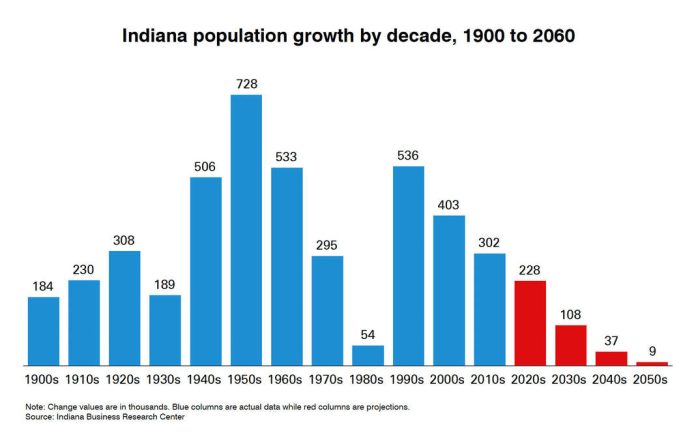
This chart shows Indiana’s actual population growth since 1990 and project growth through 2060. IBJ chart
Overall population growth in Indiana will nearly skid to a halt by the 2050s while the Indianapolis metropolitan area attracts residents at relatively robust clip over several decades, according to new projections from Indiana University demographers.
More than two-thirds of Indiana’s 92 counties will see losses in population over the next 30 years. Meanwhile, the 11-county Indianapolis metro area is expected to hit about 2,497,000 residents by 2050—an increase of nearly 405,000 from 2020.
In the 2050s, the state’s already meager overall population growth will slow further to an average gain of less than 1,000 new residents per year, according to the analysis released Wednesday by the Indiana Business Research Center at the Indiana University Kelley School of Business.
The near-static growth can be explained by a grim but relatively simple phenomenon: The number of deaths in the state will begin surpassing the number of births in the 2040s.
“To some degree, this trend was always inevitable,” said IBRC Senior Demographer Matt Kinghorn. “With the aging of the baby boom generation—a cohort that today is between the ages of 60 and 78—Indiana was sure to see … a slowdown in population growth.”
Once deaths outpace births, migration from other states will account for all of Indiana’s population growth, putting pressure on officials across the state to make Indiana as appealing a place to live as possible.
“Indiana will need to exert magnetic attraction to bring in young people from places near and far—which puts us in direct competition with every other state facing slow-to-no growth,” said Carol Rogers, director of the IBRC.
Overall, the analysis from the IBRC projects a 5.6% increase in Hoosiers between 2020 and 2060, climbing from 6.79 million to 7.17 million. However, the majority of those gains—about 60%—will take place by 2030.
Kinghorn put the state’s flagging population growth in sharp relief by noting that the number of Indiana residents grew by about 403,000 in the 2010s, which is greater than the total expected growth of 392,000 residents between 2020 and 2060.
The Indiana Business Research Center is part of a national network of state data centers and serves as Indiana’s official representative to the U.S. Census Bureau on matters relating to the census and population estimates.
So-called “natural increase”—the difference between the number of birth and deaths—has been the dominant source of Indiana’s population growth for decades. But the number of births in Indiana has been on a steep and steady decline since 2008.
At the other end of the age spectrum, Indiana’s life expectancy peaked in 2010 at 77.65 years old and has since declined by about a year. And within 10 years, the entire baby boom generation will be older than the traditional retirement age of 65, with seniors comprising one out of every five Hoosiers.
Natural increase is expected to shift from Indiana’s primary driver of growth to a drag on it in the 2040s, Kinghorn said.
Meanwhile, a handful of metropolitan areas will be responsible for nearly all of Indiana’s population growth, according to the study. The population of the 11-county Indianapolis metro area—defined as Marion County, the eight doughnut counties and Tipton and Brown counties—is expected to grow by 19.3% between 2020 and 2050.
The state’s five fastest-growing counties will be suburban Indianapolis counties. The populations of Hamilton, Boone, Hancock, Hendricks and Johnson counties will each grow by at least 25% by 2050. Marion County will finally pass the 1 million mark and reach more than 1,011,000 residents. (It was 977,203 in 2020.)
Here are the projected populations for the five fastest-growing Indy-area suburban counties in 2050 (followed by their populations from the 2020 U.S. Census).
— Hamilton: 529,505 (347,467)
— Hendricks: 250,688 (174,788)
— Johnson: 203,455 (161,765)
— Hancock: 115,401 (79,840)
— Boone: 107,634 (70,812)
Elsewhere across the state, Clark, Warrick, Allen and Bartholomew counties will grow by at least 10% by 2050, according to the IBRC projections. Lake and St. Joseph counties will see modest gains through 2035 before beginning to see slight population declines. Both counties are projected to reach 2050 with fewer residents than they have today.
By Mason King, Indianapolis Business Journal




